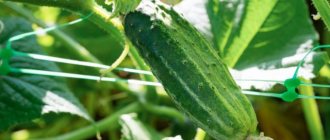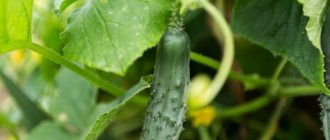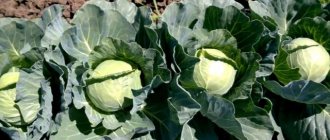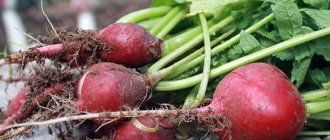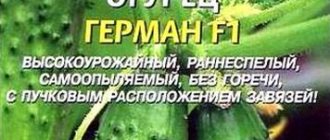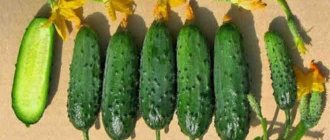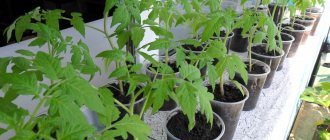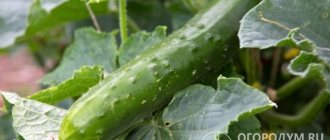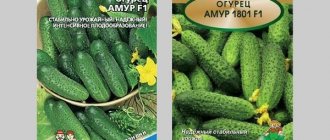Description of cucumber variety Temp F1
After the cucumber variety Temp F1 was entered into the State Register of the Russian Federation in 2006, the Moscow company Semko-Junior began supplying seeds of this crop to the Russian market. They are recommended for cultivation indoors for the Central, Northwestern, Volga, Southern, and North Caucasus federal districts. Temp cucumbers can successfully grow not only in greenhouses, but also on window sills and balconies.
Cucumber Temp F1 is parthenocarpic (capable of forming cucumbers without pollination). The plant branches weakly, is indeterminate, that is, not limited in growth, does not require formation, and has exclusively female flowers. The leaves of the crop are medium sized, bright green. In their sinuses, bunch-type ovaries are formed - up to 5 in one.
Agricultural technology or proper cultivation
The Temp variety (F1) is grown by direct planting of seeds in beds and by seedling method.
Before forming the beds, it is recommended to pour a fifteen-centimeter layer of light, fertile soil on top.
When sowing seeds directly, you should adhere to the following recommendations:
- Planting of planting material begins after the soil temperature at a depth of about 10 cm is within 16-18 degrees Celsius;
- It is recommended to mulch the seeds placed in the holes with peat with a layer of 2-3 cm;
- Cucumbers bear fruit abundantly and grow well in light, fertile soils;
- Seeds can be sown both along and across the beds using the row method;
- The best predecessors of cucumbers are potatoes, legumes, cabbage, tomatoes, and eggplants.
The depth of sowing seeds should not exceed 3-3.5 cm. The planted planting material is covered with plastic film or plexiglass.
The Temp (F1) variety is grown in seedlings mainly in the central and northern regions of Russia.
The seeds are planted in plastic containers with a nutrient soil mixture, sprinkled with warm water and covered with film. After the sprouts appear, the cover is removed. Seedlings need bright sunlight to develop and grow.
IMPORTANT: Seedlings are very difficult to tolerate picking.
Basic rules for growing cucumber seedlings:
- Watering with settled water heated to 20-25 degrees Celsius;
- In the room with seedlings, the temperature is maintained within 18-22°C during the day, and lowered to 18°C at night;
- Seedlings need double feeding with liquid mineral fertilizers;
- 7-10 days before planting, plants must be hardened at a temperature of 12-13 degrees Celsius.
- Good seedlings have a dark green color, short internodes and a thick stem.
Temp cucumber seeds can be planted directly into the ground if your area of residence is southern. For colder regions, it is better to grow seedlings. To do this, the seeds are placed in a container with prepared soil for a month. Planting depth is 3-4 cm. Containers should be located in a room with a temperature of at least 20 degrees.
From 1 sq.m. you can harvest up to 14 kg of cucumbers
Temp cucumbers thrive on trellises. Trellis greatly simplify plant care and harvesting. The fruits are not damaged, their quality improves. On trellises, cucumbers are perfectly ventilated and receive more sunlight, which means that they will get sick less.
With this method of growing, seedlings must be planted every 20 cm. A trellis is built along each row, onto which the lashes are subsequently fixed. The support can be pillars made of wood or metal. The height of the pillars must be at least 2 m. A wire is stretched between the pillars, then a plastic mesh is attached, and the plants themselves are fixed with twine.
Temp cucumbers should not be planted after zucchini and pumpkin
The Temp F1 variety can be planted in 2 ways: seeds or seedlings. Both methods give good results in terms of yield. Seeds are often sown in the south, and seedlings are grown in the center and north of Russia. Also, when planting, you need to take into account the features of each method.
Seed method:
- seeds need to be sorted by size and weight, they are hardened and heated before sowing;
- sow seeds along and across the beds;
- you can start sowing at 16-18°C;
- It is best to sow cucumbers in light and fertile soil to a depth of 3-5 cm;
- good predecessors for cucumbers: potatoes, legumes, tomatoes;
- After sowing, the holes are mulched with peat and covered with film.
Seedling:
- cucumber seedlings are planted in a special box for a month;
- you need to keep the box with seedlings in a room where the temperature is maintained at about 20°C;
- water the seedlings with warm water - 20-25°C;
Cucumber bush Temp F1
- The seedlings need to be fertilized twice with urea, potassium sulfate and superphosphate;
- 7 days before planting, seedlings are hardened at a temperature of 12-13°C.
Attention! “Temp F1” seedlings do not need to be pruned, it is even harmful.
Taste qualities of cucumbers
The fruits of the Temp variety have pronounced tubercles on the surface, their shape is normal, cylindrical. The diameter at the gherkin stage reaches 4 cm. The average weight of the fruit is about 70 g; cucumbers weighing from 35 g are suitable for harvesting.
Temp cucumbers are slightly pubescent and have white spines. The fruit pulp is dense, with a strong aroma and a sweetish taste without bitterness. When bitten, the fruit crunches; there are no voids in the middle. Fruiting continues until frost. If cucumbers are not picked in time, they do not outgrow.
Collected at the pickle or gherkin stage, the fruits are suitable for consumption fresh or canned. In salads they are combined with onions, tomatoes, peppers, and used as a side dish for meat dishes. Fresh vegetables are most beneficial. Preserving the summer harvest, Temp cucumbers are used in pickles, canned salads, and preparations for pickles.
Reviews
Raisa, 54 years old, Aramil (Sverdlovsk region)
In our polycarbonate greenhouse, self-pollinating cucumbers with bunched ovaries bear fruit best. Now we plant mainly Russian hybrids Temp, Paratunka and Siberian Garland. During the season we collect at least 15-20 kg of cucumbers from each meter of area. We often eat Paratunka fresh in salads, and for preservation I like Temp the most - small, neat cucumbers that crunch perfectly and remain firm when pickled with cold water and in marinades when poured with boiling water. The jars are a sight to behold, the taste is delicious!
Alla, 42 years old, Perm
I bought Semco Junior cucumber seeds for the first time in 2014. Even in a lean year with a cold, rainy summer, Temp F1 provided us with fresh cucumbers, which were enough for food and all winter preparations. Now I always plant 7-10 bushes every season. Whole bouquets of miniature, pimply and white-spiked ovaries are knitted in the bosoms. So that the plant has enough strength to produce such an impressive harvest, I pick many greens at the age of 3-5 days as pickles and can them immediately. Their taste is wonderful - there is no bitterness at all, the seeds are small and tender, the skin is thin.
I do not pre-treat the seeds; I plant them immediately in peat pots. Germination is very high and fast, seedling survival rate in the greenhouse is good. This variety pleases with its active fruiting in our weather conditions and resistance to diseases.
Igor, 37 years old, Moscow
I decided to add my fly in the ointment to the Temp f1 cucumber barrel. It is declared as a high-yielding hybrid, but we had few fruits. The ovaries seemed to form in bunches, but often turned yellow, dried out and fell off. On each bush, out of 15-20 pieces, at best there were 5-7 left. In terms of yield, it turned out to be much weaker than other varieties. The cucumbers themselves have decent taste. It’s nice that they are all almost identical in appearance, small and even. Very suitable for pickling and preservation. The female half of our family liked them, but I'm not sure I'll plant them again.
Olesya, 39 years old, Belorechensk
In our conditions (Krasnodar region), cucumbers feel great in open ground. There are always enough insects, but we prefer not bee-pollinated varieties, but parthenocarpics, which produce bunched ovaries and a large harvest. Now our favorite is the Temp F1 cucumber. Seeds are expensive, but the quantity and quality of cucumbers pays for these costs. We stretch the trellis and let the vines curl along it, without pinching or shaping the bushes in any way. In this form, our cucumbers almost never get sick. We harvest the first harvest at the pickle stage in just over a month. In place of the picked cucumbers, new ovaries appear; the main fruiting occurs first on the central stem, and then on the side shoots. At this time, the most important thing is to establish regular watering and abundant fertilizing. Temp f1 cucumber tolerates even our heat well and no bitterness appears in the fruit. One of the most productive, ideal for canning.
Pros and cons of the variety
Amateurs and professionals who leave their descriptions, reviews, photos about the Temp F1 cucumber consider it one of the best among short-fruited hybrids. The advantages of the variety include:
- early ripening;
- excellent taste of fruits;
- low susceptibility to diseases;
- self-pollinating;
- versatility of use;
- high productivity;
- unpretentiousness;
- resistance to extreme temperature increases (up to 50 oC);
- shade tolerance.
Since Temp is a hybrid obtained by crossing several varieties of cucumbers, it has the best characteristics of taste, color, shape, resistance to disease, temperature changes, however, the culture is no longer capable of reproducing seeds. Therefore, the disadvantages of the hybrid include the need to annually purchase seed material.
Positive and negative qualities of a hybrid
The Temp cucumber, included in the State Register, was bred for film cultivation. The positive characteristics include the following:
- Very early ripening;
- Good disease resistance;
- High percentage of seed germination;
- High yield;
- No need for picking;
- Excellent transportability;
- Resistant to thickening and shade;
- Good appearance and taste;
- Drought resistance;
- Self-pollinating;
- The versatility of the fruit;
- Adaptation to soil conditions.
Speaking about the disadvantages, all consumers say that the most important of them is the very high cost. Other, less significant negative qualities were also noted:
- If the soil is highly acidic, the cucumber stops growing and withers;
- Sudden changes in temperature negatively affect the well-being of the plant;
- Under field conditions of growing vines, crops begin to quickly dry out, the foliage turns yellow, and the fruiting period is reduced;
- A long period of dehydration leads to crushing of the fruit.
The consumer is very attracted by the lack of bitterness in the product, even when cultivated on difficult soils. Another important advantage is parthenocarpicity, which allows you to keep cucumber bushes on balconies and loggias.
Optimal growing conditions
Despite the fact that cucumber is a light-loving plant that grows poorly in shade, the Temp variety can easily tolerate light shade without losing productivity. But this feature should not be abused, since a long absence of sun leads to weakening of the plant, its aging and loss of resistance to disease.
Its optimal temperature for development is 22 – 26 oC. The growth rate of cucumber varieties slows down if it drops below 14 oC. When it drops to 12 oC or less, the roots lose their ability to take moisture from the soil. Negative temperatures lead to complete death of plants. Ventilation of greenhouses should be carried out gradually, as the air warms up to comfortable conditions.
Since the root system of the Temp variety cucumber is largely located in the upper layers of the soil, the requirements for it are quite high. This vegetable is more suitable for sandy soils enriched with organic matter.
To obtain regular harvests in a greenhouse, it is necessary to alternate planting cucumbers with beans, peppers, and tomatoes.
The crop does not tolerate heavily moist soils.
Protection from diseases and pests
Hybrid Temp F1 is characterized by increased resistance to crop diseases. It is little susceptible to powdery mildew, peronosporosis, cladosporiosis, and cucumber mosaic. This is facilitated by adherence to agricultural technology and the trellis growing method, which prevents plantings from becoming thicker. Cucumber leaves do not get moisture, which contributes to diseases.
To avoid infections, it is worth timely removing yellowed, damaged, infected leaves using sharp scissors.
Despite the resistance to diseases and pests of the Temp cucumber, aphids may appear on the vine during periods of high humidity. To combat it and for prevention purposes, both special means and home remedies are used - a weak solution of potassium permanganate.
Agricultural technology of cucumbers Temp F1
The hybrid can be grown in two ways - seedlings and seeds.
Seeds from manufacturers have most often already been prepared. If this was not the case, then they must be subjected to several procedures:
- sorting;
- hardening;
- warming up.
Agricultural technology of the Temp variety cucumber has a number of features:
- the growing location must be changed annually, returning to the same area no earlier than after 4 - 5 years;
- the soil should be light and nutritious;
- soil temperature - not less than 16 oC;
- mulching of holes or furrows is required;
- covering the soil after sowing;
- watering with warm, settled water;
- carrying out fertilizing.
Planting seedlings
Before sowing, Temp cucumber seeds for seedlings must be calibrated or sorted. For this purpose, they need to be placed in a hot saline (60 oC) solution. The seeds that have sunk to the bottom should be washed with clean water and poured into a pink solution of potassium permanganate to disinfect them. The next stage of preparation is hardening. To do this, the seeds are laid out on a damp cloth and placed in the refrigerator (at a temperature of 0 oC to -2 oC) for 48 hours. Seeds are saturated with oxygen using bubbling. A bag of cucumber seeds is placed in a glass jar for 18 hours, where an aquarium compressor is also placed. After such procedures, the germination rate of crops increases significantly.
To sow the Temp variety, you need to prepare a soil mixture consisting of:
- from peat – 6 parts;
- sand - 1 part;
- sawdust – 1 part;
- humus - 1 part;
- mullein – 1 part.
The soil can be disinfected by freezing, calcination, or chemicals.
Boxes, peat pots, and cassettes are used as containers for seedlings of Temp variety cucumbers. They should be disinfected with a solution of potassium permanganate.
Sowing in pots is carried out no earlier than 4 weeks before planting in the ground.
2 seeds are placed in each pot to a depth of 2 cm and kept at a temperature of about 25 oC until germination.
To prevent seedlings from stretching out, cucumbers need additional lighting.
After emergence of seedlings, the ambient temperature is reduced to 20 oC. Twice before planting in the greenhouse, soil is added to the pots so that the plants do not stretch out.
High-quality cucumber seedlings of the Temp variety have strong stems with short internodes, dark green leaves, and a developed root system.
Landing in the ground
Before planting, seedlings should be hardened by taking them out into the open air during the day, at above-zero temperatures, with a gradual increase in time. The duration of the procedure is a week.
The day before planting in the greenhouse, cucumbers need to be watered generously.
The soil is dug up, adding 1 - 2 buckets of compost per 1 square meter, holes are made with a depth corresponding to the size of the peat pots. The distance between the holes is 40 cm.
The pots are placed so that the edge is at ground level and watered (3 liters per plant).
If the seedlings of the Temp variety of cucumbers are of high quality, they are planted vertically, the stretched ones are planted at an angle, the root collars are treated with sand, protecting them from rot.
In the first days, seedlings should be shaded and periodically watered, and during cold weather, additional shelter should be installed.
For each plant it is necessary to install strong trellises.
According to reviews from gardeners and gardeners with descriptions and photos, cucumbers of the Temp variety grow well in “warm” beds. They are prepared in advance, two weeks before planting, by digging a trench and filling it with manure, garbage, and sawdust. After some time, the biofuel will self-heat and prepare the soil for planting seedlings.
Watering and fertilizing
After planting the seedlings and until flowering, watering the Temp variety of cucumbers is carried out regularly, but moderately, no more than 4 liters per square meter. With more moisture, the plant will intensively grow leaf mass, not ovaries. It is recommended to carry out “drying” and skip the next watering if the leaves are growing too actively.
The Temp variety is most demanding of moisture during the period of ovary formation and after harvesting cucumbers. At this time, the irrigation rate is 10 liters of water per square meter. m with a frequency of once every 2 days. Use only warm water, otherwise the root system of the plant may rot. Watering under the root can lead to its exposure, so special grooves must be created for moisture.
The first fertilizing with a solution of universal fertilizer is carried out a couple of weeks after planting the seedlings. As soon as cucumbers of the Temp variety begin to bear fruit, fertilizer with a high content of potassium and phosphorus is applied, and in the second half of fruiting - calcium nitrate.
Formation
The distinctive features of the Temp variety cucumber include the absence of the need for its formation, but for the proper development and fruiting of the crop it is necessary:
- two weeks after planting, periodically tie it to the trellis;
- leave the top free;
- pinch the stem that has reached the top of the trellis;
- remove all tendrils and flowers up to the third leaf;
- the resulting side shoots of the Temp cucumber are shortened, there is no need to pinch them;
- make sure that the vines do not creep along the ground.
Protection from diseases and pests
Hybrid Temp F1 is characterized by increased resistance to crop diseases. It is little susceptible to powdery mildew, peronosporosis, cladosporiosis, and cucumber mosaic. This is facilitated by adherence to agricultural technology and the trellis growing method, which prevents plantings from becoming thicker. Cucumber leaves do not get moisture, which contributes to diseases.
To avoid infections, it is worth timely removing yellowed, damaged, infected leaves using sharp scissors.
Despite the resistance to diseases and pests of the Temp cucumber, aphids may appear on the vine during periods of high humidity. To combat it and for prevention purposes, both special means and home remedies are used - a weak solution of potassium permanganate.
Growing and caring for cucumbers Temp
Rules for growing and caring for cucumbers Temp in greenhouses
- The lashes should not spread along the ground; to do this, they are carefully tied up, without squeezing, so as not to disrupt the circulation of juices.
- Water with warm, settled water, avoiding waterlogging and drying out of the soil.
- The soil is loosened once every 10–14 days so that a crust does not form on its surface, which will interfere with the penetration of moisture and air to the root system.
- Weeds are removed as they appear.
- To feed cucumbers, organic and mineral fertilizers are used, alternating them.
- After the bushes reach a height of 2 m, they are pinched. In case of strong thickening, remove excess side shoots and leaves.
Reference! New bushes are obtained from the removed side branches. To do this, the lower part of the shoots is placed in water; after 7–10 days, roots form on them. After this, the plants are planted in the ground.
Watering and fertilizing
This vegetable is a moisture-loving crop, but at different times it requires different amounts of watering:
- It is enough to water young plants once a week. Watering is limited before flowering so that excess moisture does not inhibit the formation of flowers and ovaries;
- during the fruiting period, the crop requires abundant watering (so that the top 15 cm layer of soil is saturated), which is repeated after 3-4 days;
- You need to water with warm water (can be heated in the sun) in the afternoon;
- sandy loam soils require more water consumption than clay soils;
- If the soil is not mulched, then to avoid cracking, loosen it after each watering.
In addition to water, fertilizing is also important for cucumbers:
- on nutritious soils, 2 feedings per growing season are sufficient, and on poor soils their number is increased to 4;
- The first feeding is carried out when 2 true leaves are formed or on the 5th day after planting the seedlings. To mullein (1 kg) diluted in a bucket of water and fermented for several days, add 10 g of ammonium nitrate, 30 g of superphosphate and 10 g of potassium sulfate. This amount is enough for 3-4 m²;
- During the flowering period, a second feeding is carried out. For it, you can use a solution of bird droppings (1:15). 50 g of potassium sulfate, 0.5 g of boric acid and 0.3 g of manganese sulfate are diluted in a bucket of water;
- nutrient solutions are introduced into furrows (5–8 cm deep) dug at a distance of 10–15 cm from the base of the bushes;
- Additional fertilizing is carried out based on the appearance of the plants. If cucumbers grow well and bear fruit, there is no need to feed them. As an additional food, you can use mullein (1 liter per bucket of water);
- The plants are watered the day before applying fertilizer. When feeding, you need to make sure that nutrient solutions do not get on the foliage and flowers.
Important! You should know that cucumbers react poorly to an excess of mineral fertilizers, so you should not abuse them or exceed doses.
Soil care
The soil on which cucumbers grow also requires certain measures:
- wet soil causes rapid growth of weeds, so they must be constantly removed;
- After watering and rain, regular loosening is required to prevent crusting. This must be done carefully so as not to damage the roots lying close to the surface;
- To avoid the appearance of a crust, you can use mulching materials (sawdust or peat), and later, from time to time, lightly loosen them. Mulch will also prevent weed growth.
Formation
The distinctive features of the Temp variety cucumber include the absence of the need for its formation, but for the proper development and fruiting of the crop it is necessary:
- two weeks after planting, periodically tie it to the trellis;
- leave the top free;
- pinch the stem that has reached the top of the trellis;
- remove all tendrils and flowers up to the third leaf;
- the resulting side shoots of the Temp cucumber are shortened, there is no need to pinch them;
- make sure that the vines do not creep along the ground.
Forming and tying a bush
The fruiting of cucumbers Temp F1 is not affected by whether they grow on a trellis or are spread on the ground. And it is not necessary to form bushes, since they are quite compact.
To strengthen untied bushes, you can sprinkle the stems with soil in several places, this will cause additional root formation and strengthen the plants. It is also necessary to regularly remove yellowed leaves and stems, which will allow the formation of additional shoots.
Cucumber yield Temp F1
The Temp variety cucumber is an early cucumber; the crop begins to ripen within 36 days after germination. At this time, the greens have a length of up to 5 cm. If there is no desire to collect pickles, then in a week they will reach the gherkin stage - about 9 cm. The average ripening period, according to the description of the State Register, is 43 days.
Judging by the reviews and photos, the yield of Temp cucumbers in a greenhouse is high, provided the correct agricultural technology is used. The total yield is 15 kg per square meter. If the fruits are picked at the pickle stage, the figure decreases to 6 kg.
Harvesting and application
The first harvest of cucumbers is harvested 40 days after planting. Although the fruits of the hybrid do not acquire bitterness if they are kept on the bushes, gardeners remove the vegetables after they reach 6 cm in length to free the bushes.
Juicy, tasty pickles and gherkins are actively used in cooking. They are pickled, salted, added to winter preparations, consumed fresh and chopped into vegetable salads. Cucumbers are often used to make traditional medicine and home cosmetology.
Cucumbers in a greenhouse: planting seedlings
Self-pollinating cucumbers are perfect for open ground, and such plants are also suitable for growing in spring film and stationary greenhouses. Hybrid Temp F1 has parthenocarpic properties, which will allow its cultivation in film greenhouses. This early-ripening vegetable crop is capable of providing a fairly early harvest of beautiful short-fruited cucumbers. Seedlings are planted in spring film greenhouses at the end of April. If they are heated, then this period can be moved forward a month. Plants are planted in rows, maintaining a distance between bushes of at least 30 cm.
Description of fruits
The resulting ovary of Temp cucumbers takes the shape of a cylinder, has a short neck and medium-sized tubercles. The length of the fruit reaches 10 cm, and the weight is up to 80 g. The gherkin is up to 6 cm, weighing up to 50 g, and the pickle is up to 4 cm, weighing up to 20 g. It should be noted that ripe cucumbers are juicy, crispy, aromatic with a delicate crust. All fruits of the Temp-f1 variety grow to approximately the same size and look neat when placed in jars.
Exotic Sparaxis: planting and care in open ground, photos, features of growing a plant with bright buds of various colors and shades on a long stem
Features and Specifications
Early ripening hybrid: the harvest begins on the 40-45th day after emergence or planting of seedlings in the beds. The cucumber is hardy and does not stop forming ovaries even when temperatures drop and during constant rains. Fruiting lasts until autumn. Resistant to cladosporiosis, powdery mildew, tolerant to peronosporosis and cucumber mosaic virus. Cucumber has high marketability and keeping quality. Thanks to the latter, it tolerates transportation well.
Productivity, taste, purpose
"Temp" produces juicy, aromatic fruits. The taste is sweet without bitterness. The purpose is universal: cucumbers are equally good in fresh vegetable salads and as a salty snack. The productivity of a hybrid depends not only on growing conditions and quality of care, but also on the moment of harvesting the fruits. Productivity per 1 m²:
- pickles – 9-10 kg;
- gherkins – 14-20 kg.
Advantages and disadvantages
- self-regulation of branching - the participation of the vegetable grower in the formation of the bush is minimized;
- no tendency to overgrow and yellow;
- stable yield even in rainy and cool conditions;
- heat resistance;
- high marketability and shelf life;
- excellent productivity;
- versatility of use;
- excellent immunity to diseases.
The best varieties for the greenhouse
The most important criteria that you need to focus on when selecting cucumbers for a greenhouse are self-pollination and plant size. The presence of insects cannot be guaranteed. Manual pollination is a rather labor-intensive and time-consuming procedure.
Table: description of cucumber varieties suitable for cultivation in greenhouses
| Variety name | Most suitable region for cultivation | Ripening time | Self-pollinating | Appearance of the bush | Type of ovary | Presence of immunity | Dangerous diseases | Appearance and taste of fruits | Productivity, fruiting | Other characteristic features |
| Son-in-law | Central | Early (42 days) | Yes | The bush is indeterminate, the branching intensity is average | Bundle, 3 or more fruits | Powdery mildew | Downy mildew | Zelentsy weigh about 90 g, grow to 8–10 cm. The skin is streaked with vague pale green stripes. The tubercles are numerous, medium-sized, the edges are densely whitish, the spines are soft. Cucumber, in principle, without the slightest bitterness | Up to 13.2 kg/m² | Easy to care for. Does not pay attention to hot weather and high humidity. When outgrown, the pulp and skin retain their color and density, but the shape of the fruit changes from elliptical to barrel-shaped |
| Mother-in-law | Central, Northwestern. But the experience of gardeners shows that this cucumber can withstand more severe climatic conditions. | Early (44 days) | Yes | Indeterminate bush, medium branched | Bundle, 3 or more fruits | Powdery mildew | Downy mildew | Zelentsy grow up to 10–12 cm and gain a weight of 102 g. The entire skin is covered with fuzzy pale green streaks. The cucumber is finely tuberculate, the edges are whitish, and not particularly dense. Pulp without voids. | 12.2 kg/m² | The flowers are mostly female |
| Tempo F1 | Recognized as most suitable for cultivation west of the Urals, but successfully takes root and bears fruit in a sharply continental climate | Early (43 days) | Yes | The plant is indeterminate, with few lateral branches formed. | Bundle, more than 3 fruits | Cladosporiosis, powdery mildew | Downy mildew, mosaic virus | Zelenets reaches a length of 6–8 cm and gains a mass of 70–80 g, and is noticeably tuberous. The lower half is streaked with narrow white strokes. The edge is whitish, sparse. The pulp is completely free of bitterness and voids | More than 14 kg/m² | Flowers are only female. The variety survives drought very well |
| red mullet | It shows itself best in the European part of Russia, but also in the Urals and beyond it produces good harvests | Early (43 days) | Yes | Indeterminate bush, actively branching | Bundle, more than 3 fruits | Powdery mildew | Downy mildew | Zelentsy grow up to 8–9 cm and gain a mass of 95 g. The tubercles are not particularly noticeable, but numerous. The edge is not too thick, white. About a third of the vegetable below is covered with vague pale streaks. The pulp is devoid of bitterness | 14.8 kg/m². Fruiting lasts about two months | The flowers are exclusively female. Overripe fruits do not turn yellow or overgrow. |
Advantages and disadvantages
- Among the “advantages” of these cucumbers are:
- suitable for greenhouse cultivation and open ground;
- do not require pollination;
- early fruit ripening (37–44 days after emergence);
- high yield (up to 7 kg per 1 m² when collecting gherkins and about 15 kg per 1 m² when collecting long greens);
- the yield is stable even in unfavorable conditions;
- fruits without voids, universal in use;
- high resistance to major diseases of cucumbers;
- resistance to planting density, shade tolerance;
- tolerate temperatures up to +40°C, rainy and cold weather;
- unpretentious in care.
Cucumber seedlings
Seedlings can be grown at home. When to plant cucumber seedlings? For film greenhouses, seeds are sown in early April. Cucumbers do not take root well if the root system is damaged. Therefore, the seeds are sown in cups or peat pots.
Two seeds are placed in each of them. If purchased hybrid seeds are not treated with growth stimulants, they are sorted before sowing, removing damaged and defective ones. After this, the seeds are soaked. Germinated seeds germinate faster. Seedling containers are filled with a special earthen mixture. It's easy to prepare it yourself. The soil mixture consists of garden soil, peat and sand. After sowing, the cups are covered with film and placed in a warm place. When sprouts appear, you will need good lighting. Caring for seedlings is quite simple. This means regular watering and creating the necessary temperature and light conditions. At the age of twenty or twenty-five days it is planted in closed ground.
When to plant cucumber seedlings for open ground? The seedlings are moved to the beds when stable warm weather sets in, when the threat of spring temperature drops has passed. Ready planting material is planted in late May or early June. Therefore, sowing seeds for seedlings occurs at the beginning of May. In this case, the plants have three or four well-developed leaves.
Description
The hybrid is modern, therefore it meets the basic requirements of summer residents. Tolerates changeable weather well. It produces fruits even during periods of prolonged rain, which is not typical for every variety (hybrid). Description of the variety guarantees good yield.
When harvesting fruits in the gherkin phase, the yield can reach up to 15 kg per square meter of ridge. The productivity of the hybrid is 2 times lower if the pickles are removed.
Note to summer residents: cucumber fruits measuring from 6 to 8 cm are classified as gherkins; specimens measuring from 3 to 5 cm in length are called pickles.
Cucumber Temp is an indeterminate plant. The lashes do not stop growing until the growth point is removed. The number of leaves and shoots on the bushes is average. Work on plant formation is minimal. It is recommended to plant 3 plants per meter. When growing a bush with one stem, compact planting with an interval of 30 cm is permissible. It should be noted that the fruits ripen early. Pickles begin to be collected on the 38th day, greens and gherkins a little later (40 - 45 days).
The plant has bunch-type fruiting; 2 to 5 small cucumbers are tied in a node. With a diameter of 4 cm, the length of the greens reaches approximately 10 cm. The average greens weigh about 80 g. The flesh is crisp, tasty, without bitterness and voids. The skin is tender, finely lumpy. The spikes are white.
For preparations (canned vegetables), it is recommended to collect fruits in the pickle or gherkin phase. Fruits of this size have good marketability and taste, and the products from them are of high quality.
Landing
Grown by seedlings and without seedlings. Seeds are sown in containers after preliminary moistening of the soil. They are sealed to a depth of 2 cm. The containers used are cassettes with a side of 10 cm and cups of 300-400 ml, so as not to damage the roots during transplantation.
When preparing a soil mixture, the following is added to the substrate:
- wood ash ½ cup;
- urea 1.3 tsp;
- 30 g of phosphorus-potassium mixture.
- fertilizers are given per 10 kg of soil substrate.
The following conditions are maintained for seedlings:
- temperature 25-27 degrees before germination, 20-22 degrees after germination;
- humidity within 80-90%;
- regular irrigation with a spray bottle;
- illumination 15-16 hours a day (phytolights included).
Seeds are sown in the beds using a dry method in the last week of May in the middle zone.
The layout on the site is 3-4 bushes per 1 m2.
Growing in open ground
Temp F1 cucumber seeds can be sown directly on prepared beds. Planting cucumbers in the ground is possible when the surface layer is heated to fourteen degrees Celsius. When choosing a site, keep in mind that cucumbers should not be grown after zucchini and pumpkin. The best predecessors will be early white and cauliflower cabbage, potatoes and onions.
You should also pay attention to the soil. It should be quite fertile and loose. The site is located in a well-lit place protected from drafts. Before sowing seeds, it is weeded, loosened and leveled. At the same time, organic and mineral fertilizers are applied. The seeds are sown in furrows, between which a distance of fifty centimeters is maintained.
Two seeds are placed in them at a distance of at least thirty-five centimeters. Planting density should not exceed three or four plants per square meter. With more dense cultivation, the plant's feeding area decreases. This reduces productivity and increases the risk of disease and pests.
Watering and hilling mode
Variety Temp F1 is not very demanding in terms of care. But this component affects the yield of the crop and the taste of future fruits. Fertilize the soil regularly. Proper care involves:
- Watering the vegetable when the soil is completely dry. Do this in the morning or evening. During fruit formation, moisture should be regular.
- Mulch and loosen the soil after watering.
- Regularly apply nitrogen, phosphorus and other fertilizers
- You can tie the lashes to determine their growth and limit it.
Maintain air humidity at 88%. Watering should be done 2-3 times every 7 days. For better development of the root system, mulch and loosen the soil. Carry out prevention against infestations and pest infestations.
The fruits do not lose their presentation during long-term storage. Harvest in July, as the variety is early ripening. Storage of fresh cucumbers can last up to 5 days. For long-term storage, do not cut off the stem and leave it in water in the refrigerator. This way they can maintain their quality for a month. Freezing is practiced, which allows you to preserve all the taste of cucumbers.
Seedling method
Cucumber seedlings are grown in order to obtain the first harvest a couple of weeks earlier than when sowing seed directly into the ground. Hybrid cucumbers "Temp-f1" are grown in seedlings most often in the central and northern regions of Russia.
It is advisable to grow cucumber seedlings in special boxes for one month, and then transplant the plants into greenhouses or open ground. Cucumber seedlings are very difficult to tolerate picking, and in addition, they need to comply with the following growing rules:
- You need to water the seedlings with warm, heated to 20-25°C, settled water;
- the temperature during the day should be maintained at 18-22°C, and at night reduced to 18°C;
- double feeding should be done with a solution of urea, potassium chloride or sulfate and superphosphate;
- a week before planting, the seedlings are hardened at a temperature of 12-13°C.
Good cucumber seedlings should have a thick stem, short internodes and a dark green color.
Plant resistance to diseases
Tempo F1 is highly resistant to pests and diseases. Breeders protected it from:
- powdery mildew;
- peronosporosis;
- cladosporiosis;
- mosaic disease.
Fungal diseases often appear as a white coating on bushes and leaf blades. The reasons for the formation are improper watering and temperature changes. Fungicides and copper sulfate are used for treatment. All infected parts of the plant should be immediately pulled out and destroyed.
Olive spot (cladosporiosis) is a fungal disease. It parasitizes plants as a result of temperature fluctuations. Brown spots cover the leaves and lashes, gradually drying out. The growth of cucumbers stops. Use a fungicide as a preventative measure.
The hybrid origin of the variety means that it is vulnerable to disease, so prevention is necessary. Premature administration of the necessary medications will help prevent the occurrence of unwanted diseases. The main pests for cucumbers are:
- bedbugs;
- aphid;
- slugs
Products that are good for the liver and pancreas, harmful to humans, which cleanse, restore
The leaves curl when the cucumber bug appears. For treatment, use an infusion of tobacco or chamomile. Spray the lower parts of cucumber bushes with it twice in one month.
Aphids interfere with the green mass, creating a good environment for bacteria to multiply. The leaf blades wrinkle. For prevention, weeds must be removed. Red pepper works well in the fight against aphids.

